 Last additions - Otsu 大津市 Last additions - Otsu 大津市 |
|
|
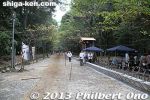
The yabusame horse track. They first hold a Shinto ceremony at the shrine.Apr 14, 2014
|
|
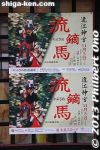
Yabusame horseback archery is held on the first Sunday in June from 12:30 pm. (Used to be held on Nov. 3.) I believe this is Shiga's only authentic yabusame.Apr 14, 2014
|
|
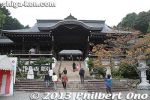
Gehaiden Hall (Outer Haiden 外拝殿)Apr 14, 2014
|
|
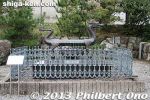
Apr 14, 2014
|
|
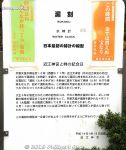
About the water clock.Apr 14, 2014
|
|
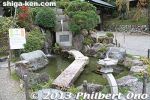
Water clock (clepsydra). Emperor Tenchi made Japan's first clock which was a water clock. Hence, the shrine is associated with clocks.Apr 14, 2014
|
|

Apr 14, 2014
|
|
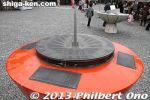
Hidokei II (日時計2: Sundial II)Apr 14, 2014
|
|
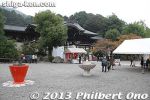
Apr 14, 2014
|
|
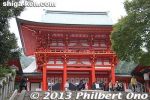
Omi Jingu Shrine's Rōmon Gate (楼門)Apr 14, 2014
|
|
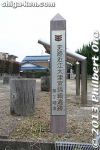
Second site of the Otsu Palace at Nishikori is a National Historic Site called Omi-Otsu-no-Miya Nishikori Iseki.Apr 14, 2014
|
|
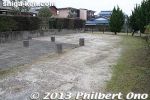
Second site of the Otsu Palace at Nishikori. MAPApr 14, 2014
|
|
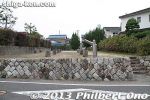
Near the first Otsu Palace site is this second site of the Otsu Palace's main building when Otsu was Japan's capital for 5 years from 667. Now an open space. 近江大津宮錦織遺跡Apr 14, 2014
|
|
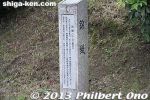
Monument about the Nishikori place name, originating from brocade weavers in this area. 錦織Apr 14, 2014
|
|
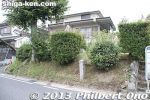
Monument about the Nishikori place name. 錦織Apr 14, 2014
|
|

Before this site at Nishikori in Otsu was unearthed, it was uncertain exactly where the Otsu Palace was located. In 1978, further archaeological evidence showed that this was indeed where the main palace building was. 近江大津宮Apr 14, 2014
|
|
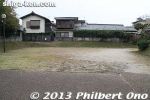
National Historic Site of Omi-Otsu Palace building in Nishikori. Thirteen large pillar holes of a long building was first discovered here in 1974. Otsu was Japan's capital for only 5 years from 667. 近江大津宮Apr 14, 2014
|
|
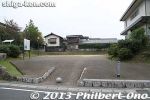
Along the way from Omi Jingu-mae Station to Omi Jingu Shrine, there are two sites of the old Omi-Otsu Palace built when Japan's capital was located here in 667. 近江大津宮錦織遺跡 MAPApr 14, 2014
|
|
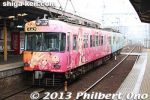
In late 2013, the Keihan Ishiyama-Sakamoto Line in Otsu had trains painted in the Chihayafuru design to promote a Chihayafuru exhibition at Omi Shrine. Omi Shrine is near Omi Jingu-mae Station.Apr 14, 2014
|
|
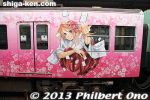
The winner of the men's division is called Meijin and the winner of the women's division is called Queen. The popular manga/anime Chihayafuru has brought international attention to karuta.Apr 14, 2014
|
|
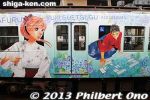
Omi Jingu is noted for competitive karuta card games. The Japanese national championship tournament of competitive karuta is held in January at Omi Jingu (since the mid-1950s). Apr 14, 2014
|
|
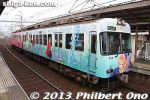
Omi Jingu Shrine is dedicated to Emperor Tenji (Tenchi 天智天皇) who moved the capital from Asuka, Nara to Otsu in 667 at the location of this shrine. Otsu was therefore once the capital of Japan. Apr 14, 2014
|
|
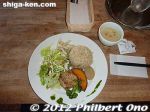
The university also has a pleasant cafeteria called “Yui” near the lake shore where you can have lunch.Jan 20, 2013
|
|
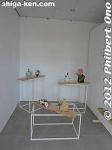
Seian University of Art and Design is Shiga’s sole art university. It’s a small university with about 800 students or 200 students per class from freshman to senior. It offers five programs/faculties and over half of the students belong to the IllustrJan 20, 2013
|
|
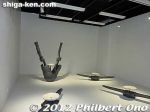
This is sculpture by Hiromu Okuda (奥田博士), a Shiga-born artist.Jan 20, 2013
|
|
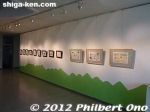
The university also strives to take an active part in the local community and be an active contributor to the local community. For example, they recently published a well-illustrated brochure created by students to introduce eateries along the Kosei Line.Jan 20, 2013
|
|
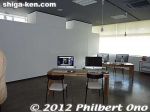
Internet roomJan 20, 2013
|
|
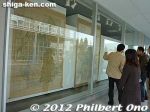
Window gallery at Seian University.Jan 20, 2013
|
|
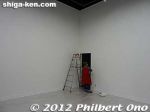
Jan 20, 2013
|
|
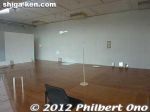
Jan 20, 2013
|
|
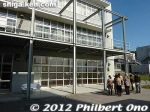
One of the larger galleries at Seian University.Jan 20, 2013
|
|
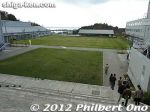
In Japanese. the university is called Seian Zokei Daigaku 成安造形大学.Jan 20, 2013
|
|
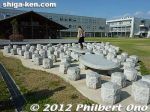
Most of the time, the galleries show work by the students. They undergo a screening to get an exhibition slot, so you can bet that the quality is high.Jan 20, 2013
|
|
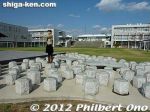
It is indeed like an art museum with numerous galleries on campus open to the public.Jan 20, 2013
|
|
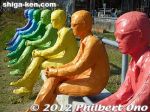
I was impressed with Seian University's slogan of being an ”Art Museum on Campus.” These colorful men are gazing at Lake Biwa.Jan 20, 2013
|
|
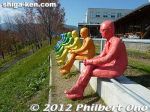
Outdoor sculpture at Seian University of Art and Design in western Otsu (near Ogoto Onsen Station on the JR Kosei Line). Seian is Shiga's sole art college.Jan 20, 2013
|
|
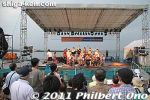
The B-grade gourmet battle was part of the Hama-Otsu Summer Festa which included a free jazz concert. I'm sure they will hold this B-class Gourmet food festival every year. Don't miss it, and go early.Sep 01, 2011
|
|
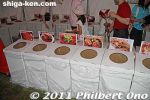
It was a gourmet battle, so we could vote for our favorite B-class food by throwing away the wooden chopsticks in the these trash bins for each food booth. They weighed these bags of chopsticks and the heaviest won the battle.Sep 01, 2011
|
|
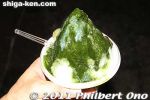
Matcha shaved ice for dessert. I ended up buying two 1000-yen ticket books. Cheap food, but you want to try as much as possible and end up spending around 2,000 yen.Sep 01, 2011
|
|
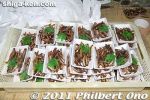
Fish from Okishima island. 200 yen per pack.Sep 01, 2011
|
|
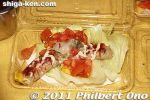
Omi Italian sausage. Hot dog like I've never tasted before. Very good.Sep 01, 2011
|
|
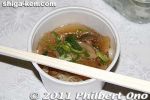
Sep 01, 2011
|
|
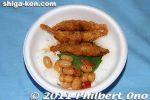
Fried fish and sweet beans over rice. Interesting combination.Sep 01, 2011
|
|
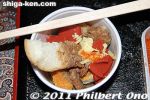
However, I did manage to buy some food at a few booths, and all were very good. Tasty like I've never tasted before. Unique and original dishes I would say. This is red devil's tongue with gravied bread.Sep 01, 2011
|
|
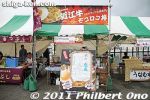
I went on the second day in mid-afternoon and already many booths had sold out. This is a "Sold out" (kanbai 完売) sign.Sep 01, 2011
|
|
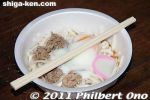
Cold noodles with Omi beef.Sep 01, 2011
|
|
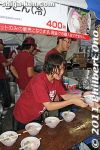
They employed a ticket system, so we had to buy a book of tickets. Each ticket was worth 100 yen and the food was priced from 100 to 500 yen.Sep 01, 2011
|
|
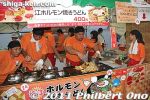
All the B-grade food served had some homegrown ingredient from Shiga. Whether it was Omi-gyu beef, red devil's tongue, Omi-mai rice, or Biwako fish. This is yaki-udon noodles.Sep 01, 2011
|
|
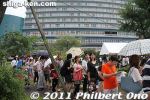
There was hardly any crowd control nor crowd direction. We just had to work our way through the lines when moving to another booth. Some lines extended all the way to the hotel behind the park.Sep 01, 2011
|
|
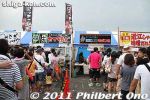
Long lines were the norm at most food booths lined along the lakefront.Sep 01, 2011
|
|
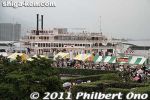
The 1st Shiga B-grade (B-kyu) Gourmet Battle was held in Otsu on July 30-31, 2011 on the Hama-Otsu lakefront. B-class (B-kyu in Japanese) gourmet is food that is cheap and aimed for the working class. It could also be good 'ol home cooking. *Note that this event is no longer held annually.Sep 01, 2011
|
|
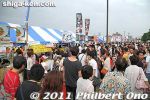
B-grade food festivals have proven to be popular in various parts of Japan and Shiga finally started its own. With an estimated 120,000 attendees over the two-day period, Shiga's first B-class food fest was wildly popular as you can see by this crowdSep 01, 2011
|
|
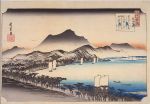
Hiroshige's woodblock print of Clearing Storm at Awazu from his "Omi Hakkei" (Eight Views of Omi) series.Apr 24, 2011
|
|
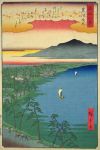
Hiroshige's woodblock print of Clearing Storm at Awazu from his "Omi Hakkei" (Eight Views of Omi) series. Zeze Castle can be clearly seen.Apr 24, 2011
|
|
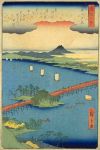
Hiroshige's woodblock print of Evening Glow at Seta from his "Omi Hakkei" (Eight Views of Omi) series.Apr 24, 2011
|
|
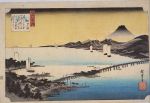
Hiroshige's woodblock print of Evening Glow at Seta from his "Omi Hakkei" (Eight Views of Omi) series.Apr 24, 2011
|
|
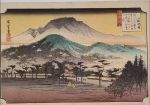
Hiroshige's woodblock print of Evening Bell at Miidera temple from his "Omi Hakkei" (Eight Views of Omi) series.Apr 24, 2011
|
|

Hiroshige's woodblock print of Evening Bell at Miidera temple from his "Omi Hakkei" (Eight Views of Omi) series.Apr 24, 2011
|
|
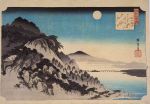
Hiroshige's woodblock print of Autumn Moon at Ishiyama from his "Omi Hakkei" (Eight Views of Omi) series. The temple on stilts and Moon-viewing Pavilion is visible.Apr 24, 2011
|
|

Hiroshige's woodblock print of Autumn Moon at Ishiyama from his "Omi Hakkei" (Eight Views of Omi) series. The Moon-viewing Pavilion is visible.Apr 24, 2011
|
|
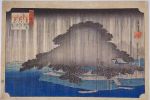
Hiroshige's woodblock print of Night Rain in Karasaki from his "Omi Hakkei" (Eight Views of Omi) series. Apr 24, 2011
|
|
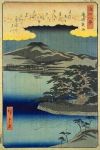
Hiroshige's woodblock print of Night Rain in Karasaki from his "Omi Hakkei" (Eight Views of Omi) series. Apr 24, 2011
|
|
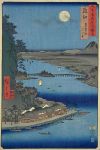
Hiroshige's woodblock print of Ishiyama-dera from his "Famous Views of the 60 Provinces" series. Looking toward Lake Biwa.Apr 24, 2011
|
|
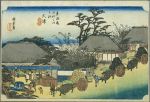
Hiroshige's woodblock print of Otsu-juku from his "Fifty-Three Stations of the Tokaido Road" series. Apr 24, 2011
|
|
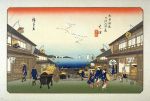
Hiroshige's woodblock print of Otsu-juku (70th post town on the Nakasendo) from his Kisokaido series. Hatcho-dori street and Lake Biwa in the distance.Apr 24, 2011
|
|
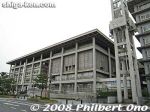
Otsu City Hall. The clock plays Lake Biwa Rowing Song.Apr 24, 2011
|
|

Senko-sai video (embedded).Aug 22, 2010
|
|
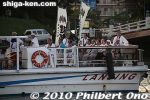
By 6 pm, all the boats left and we would have to wait 2 hours to see the fireworks when they returned. Unfortunately, I couldn't stand the heat and left. Perhaps I'll see the fireworks someday.Aug 20, 2010
|
|
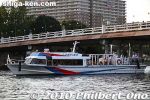
Lansing passing under Seta-no-Karahashi Bridge.Aug 20, 2010
|
|
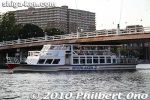
Interlaken passing under Seta-no-Karahashi Bridge.Aug 20, 2010
|
|
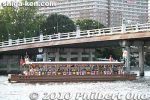
A yakata-bune shrine boat passes under Seta-no-Karahashi Bridge. This festival reminded me of the Tenjin Matsuri in Osaka, but on a smaller scale.Aug 20, 2010
|
|
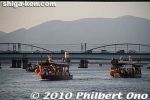
Other boats follow. They all proceeded to the shrine's Otabisho near the Nango sluice on Seta River. A Shinto ceremony would be performed there before they returned back to Seta Karahashi Bridge at 8 pm.Aug 20, 2010
|
|
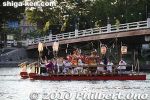
Boat with the three portable shrines pass under Seta-no-Karahashi Bridge.Aug 20, 2010
|
|
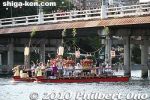
Boat with the three portable shrines pass under Seta-no-Karahashi Bridge.Aug 20, 2010
|
|
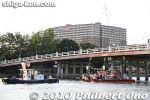
Aug 20, 2010
|
|
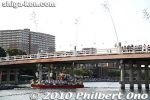
Aug 20, 2010
|
|
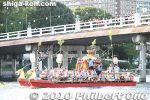
Boat with the main portable shrine pass under Seta-no-Karahashi Bridge.Aug 20, 2010
|
|
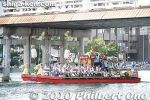
Boat with the main portable shrine pass under Seta-no-Karahashi Bridge.Aug 20, 2010
|
|
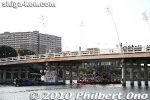
Heading the boat procession is the main mikoshi now passing under Seta-no-Karahashi Bridge.Aug 20, 2010
|
|
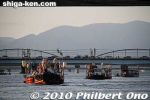
After making a U-turn, the boats head downstream toward Seta-no-Karahashi Bridge.Aug 20, 2010
|
|
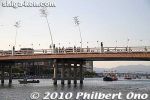
The crowd watching the boat procession was sparse. It seems most people were waiting for the fireworks instead. It was a hot day too.Aug 20, 2010
|
|
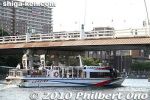
Lansing going to rendezvous with the other boats. Most of Lake Biwa's cruise boats are named after Shiga's sister states (like Michigan) or cities. Lansing is in Michigan.Aug 20, 2010
|
|
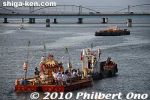
The fireworks barge can be seen on the distance.Aug 20, 2010
|
|
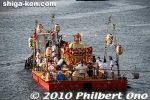
Aug 20, 2010
|
|
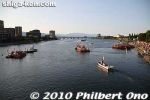
All the boats first head upstream toward Lake Biwa, then they make a U-turn and sail downstream down Seta River.Aug 20, 2010
|
|
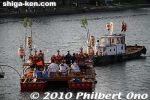
The three mikoshi head upstream.Aug 20, 2010
|
|
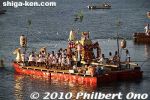
The main mikoshi on the boat during the Senko-sai festival on Setagawa River in Otsu.Aug 20, 2010
|
|
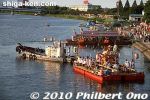
Next, the boat carrying the main mikoshi is taken upstream. Aug 20, 2010
|
|
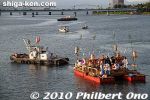
Aug 20, 2010
|
|
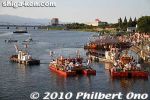
The boat with the three mikoshi aboard is pulled away by tugboat.Aug 20, 2010
|
|
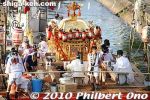
The main mikoshi all set on the boat.Aug 20, 2010
|
|
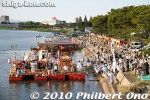
Boat pier north of the east end of Seta-no-Karahashi Bridge. This is where the crowd was concentrated. People gave a few speeches before the boats left.Aug 20, 2010
|
|
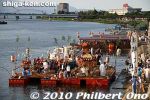
Aug 20, 2010
|
|
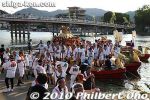
Aug 20, 2010
|
|
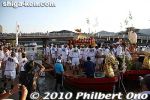
Aug 20, 2010
|
|
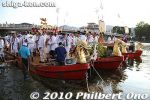
All the mikoshi are loaded up on the boats and ready to go.Aug 20, 2010
|
|
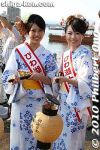
The two Biwako Otsu Tourist Ambassadors for 2010, Inoue Madoka and Nagata Megumi. Selected from among 21 applicants in April 2010. For one year, their job is to promote tourism in Otsu. びわ湖大津観光大使:井上まどか、永田めぐみAug 20, 2010
|
|
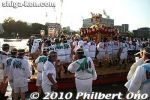
Aug 20, 2010
|
|
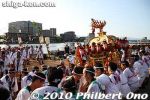
Hauling the main mikoshi onto the boat.Aug 20, 2010
|
|
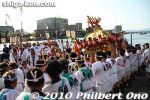
Aug 20, 2010
|
|
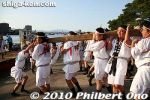
Carrying the main mikoshi to the boat.Aug 20, 2010
|
|
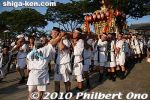
Heading for the boat.Aug 20, 2010
|
|
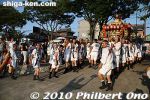
The main mikoshi arrives at the boat pier.Aug 20, 2010
|
|
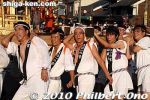
Aug 20, 2010
|
|
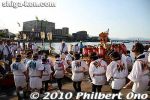
The mikoshi carried by the ladies is loaded onto the boat.Aug 20, 2010
|
|
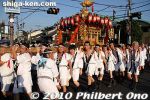
Aug 20, 2010
|
|
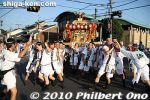
Aug 20, 2010
|
|
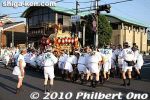
Aug 20, 2010
|
|
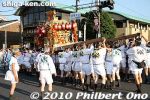
They do a few maneuvers with the main mikoshi.Aug 20, 2010
|
|
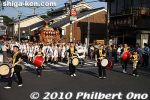
Aug 20, 2010
|
|
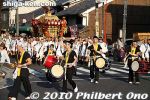
Escorted by taiko drummers, the main mikoshi arrives at the east end of Seta-no-Karahashi Bridge.Aug 20, 2010
|
|
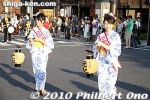
The two Biwako Otsu Tourist Ambassadors for 2010. びわ湖大津観光大使:井上まどか、永田めぐみAug 20, 2010
|
|
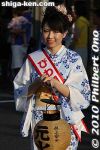
Nagata Megumi, Biwako Otsu Tourist Ambassador for 2010, was also in the procession. 永田めぐみAug 20, 2010
|
|
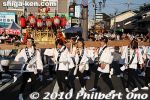
Aug 20, 2010
|
|
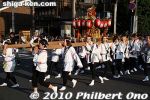
Aug 20, 2010
|
|
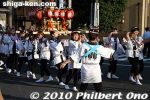
The third mikoshi was carried by women.Aug 20, 2010
|
|
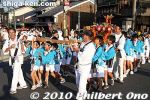
Aug 20, 2010
|
|
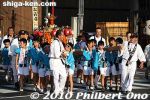
Followed by another children's mikoshi.Aug 20, 2010
|
|
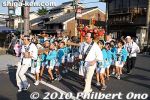
First was a children's mikoshi (portable shrine).Aug 20, 2010
|
|
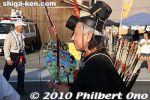
ArcherAug 20, 2010
|
|
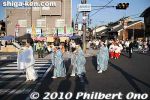
Even though this is one of Otsu's Big Three Festivals (others are Sanno-sai and Otsu Matsuri), the crowd watching was surprisingly sparse. Aug 20, 2010
|
|
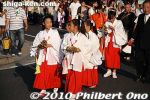
Shrine maidensAug 20, 2010
|
|
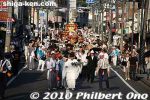
The festival started at 5 pm when the mikoshi (portable shrine) procession departed Takebe Taisha Shrine about 500 meters from the east end of Seta-no-Karahashi Bridge.Aug 20, 2010
|
|
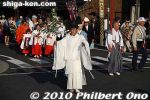
The procession arrived at the east end of Seta-no-Karahashi Bridge at about 5:15 pm.Aug 20, 2010
|
|
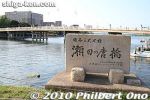
Seta-no-Karahashi Bridge.Aug 20, 2010
|
|
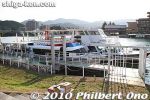
These two cruise boats (Lansing and Interlaken) were chartered for the festival.Aug 20, 2010
|
|
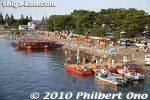
Pier scene near Seta-no-Karahashi Bridge.Aug 20, 2010
|
|
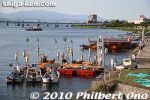
Mikoshi boats await the mikoshi.Aug 20, 2010
|
|
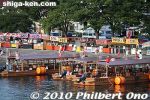
More boats to be in the procession.Aug 20, 2010
|
|
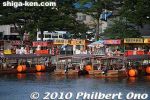
Aug 20, 2010
|
|
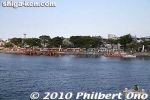
The east bank of Seta River near Seta-no-Karahashi Bridge.Aug 20, 2010
|
|
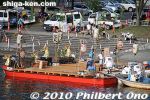
The two mikoshi boats have dragon heads.Aug 20, 2010
|
|
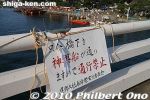
Sign says that people cannot enter the middle section of the bridge under which the mikoshi will pass.Aug 20, 2010
|
|
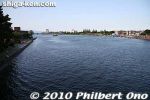
The Senko-sai festival personifies the marine journey of legendary prince and warrior Yamato Takeru. It also prays for water safety. Yamato Takeru is one god Takebe Taisha Shrine worships.Aug 20, 2010
|
|
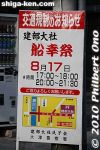
One of Otsu's Big Three Festivals, the Senko-sai is a portable shrine procession on boats going down Seta River from Seta-no-Karahashi Bridge to Nango sluice and back. Held annually on Aug. 17 by Takebe Taisha Shrine. The festival starts at 5 pm.Aug 20, 2010
|
|
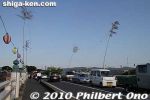
Seta-no-Karahashi Bridge had four bamboo poles indicating where the mikoshi (portable shrine) boats will pass under. These photos were taken on Aug. 17, 2010, a very hot day. MAPAug 20, 2010
|
|
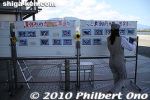
Photographers are on the prowl on the boat, offering to take your picture. After the cruise, you can buy a photo for 1,000 yen.Aug 19, 2010
|
|

Plaque about the Michigan.Aug 19, 2010
|
|

Letter of appreciation from the governor of Michigan in 2006. Click to read the letter.Aug 19, 2010
|
|
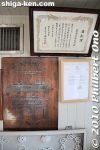
CertificatesAug 19, 2010
|
|
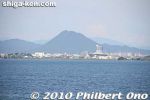
Mt. Mikami (Omi-Fuji).Aug 19, 2010
|
|
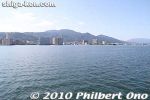
Western Otsu.Aug 19, 2010
|
|
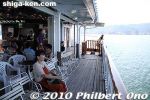
3rd floor deck.Aug 19, 2010
|
|
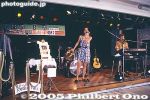
Entertainment stage on 3rd floor. The entertainers always seem to be from Australia. Instead of a trio, I think they now got only one entertainer.Aug 19, 2010
|
|
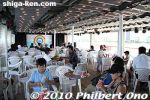
Featuring an entertainment stage, Becky's Square on the 3rd floor is the largest area for passengers. Unfortunately, it's not air-conditioned.Aug 19, 2010
|
|
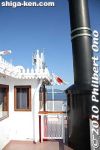
Aug 19, 2010
|
|

Open deck.Aug 19, 2010
|
|
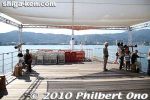
As the boat turns, the sun's striking area changes. People leave wherever the sun strikes in the heat of summer. Aug 19, 2010
|
|

Aug 19, 2010
|
|
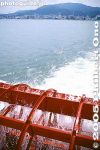
Michigan paddlewheel.Aug 19, 2010
|
|
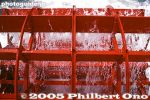
Aug 19, 2010
|
|
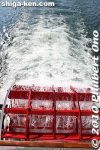
Aug 19, 2010
|
|
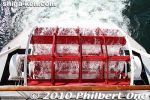
Aug 19, 2010
|
|
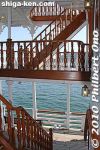
Wooden staircase on the Michigan paddlewheel boat.Aug 19, 2010
|
|
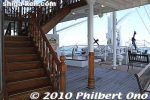
BowAug 19, 2010
|
|
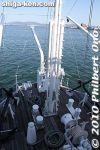
Bow of Michigan.Aug 19, 2010
|
|
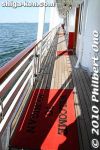
2nd floor welcome mat.Aug 19, 2010
|
|
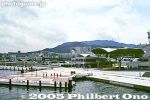
Leaving Otsu Port as the ground crew wave us off.Aug 19, 2010
|
|
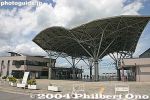
Otsu Port as seen from the boat dock.Aug 19, 2010
|
|
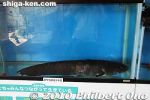
Lake Biwa catfish, a native species not found anywhere else in the world.Aug 19, 2010
|
|
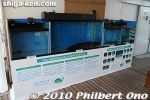
During Aug. 2010, they displayed some native Lake Biwa fish in fish tanks on the boat.Aug 19, 2010
|
|
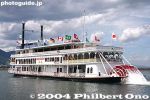
Michigan paddlewheel boat leaving Otsu Port, Shiga Prefecture, Japan.Aug 19, 2010
|
|
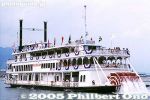
An earlier photo of the Michigan. Notice the different trimmings.Aug 19, 2010
|
|
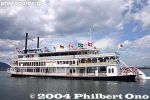
Those international flags on the top deck weren't there when I went in Aug. 2010.Aug 19, 2010
|
|
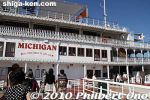
Going to board the Michigan paddlewheel boat.Aug 19, 2010
|
|
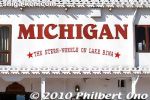
Spelling mistake...Aug 19, 2010
|
|
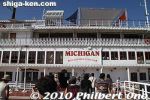
This was going to be a one-hour cruise around the Lake Biwa. This cruise which departs Otsu at 3:30 pm is called Michigan 60. Costs 2,200 yen for adults and half price for elementary schoolers.Aug 19, 2010
|
|
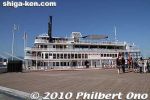
Michigan boat at Otsu Port. I would call this boat suited for spring and fall. The open-air design can make it too hot or too cold if you don't opt to pay extra to relax in the air-conditioned rooms.Aug 19, 2010
|
|

Aug 19, 2010
|
|
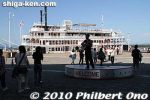
Now, only one entertainer performs as passengers board the boat in Aug. 2010.Aug 19, 2010
|
|
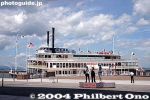
Aug 19, 2010
|
|
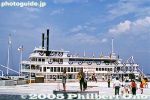
A trio of entertainers perform while passengers board the boat.Aug 19, 2010
|
|
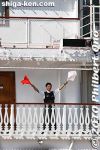
Before we could board, they had this flag signal session.Aug 19, 2010
|
|
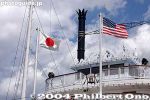
Aug 19, 2010
|
|
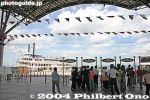
At Otsu Port, passengers wait to board the Michigan.Aug 19, 2010
|
|
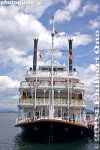
Front of the Michigan boat.Aug 19, 2010
|
|
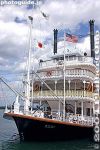
The Michigan first sailed in April 1982. It is 59 meters long and 11.7 meters wide. With 700 horsepower, it can cruise up to 8.65 knots.1982年4月2日進水。939.7総トン、全長59.0m、幅11.7m、出力700馬力、最高速力8.65ノット。
旅客定員787名。Aug 19, 2010
|
|
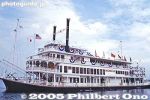
Michigan looking slightly different from years ago. Accommodates 787 passengers.Aug 19, 2010
|
|
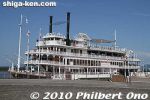
Most of Lake Biwa's cruise boats are named after Shiga Prefecture's sister states or cities. Michigan, USA is Shiga's sister state. Michigan is home to the largest lake in the US, while Shiga is home to Japan's largest lake.Aug 19, 2010
|
|
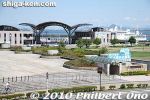
Otsu Port as seen from Hama-Otsu Station. It's a 3-min. walk from the station. MAPAug 19, 2010
|
|
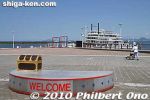
Otsu Port for Michigan. These photos were taken in Aug. 2010 and earlier years. You can see how the boat's trimmings look different.Aug 19, 2010
|
|
|
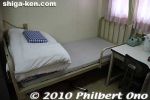
Infirmary for anyone feeling sick. 保健室Aug 19, 2010
|
|
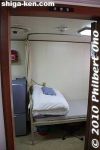
Infirmary 保健室Aug 19, 2010
|
|
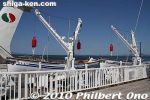
More cutter boats. They accommodate ten kids and two adults. They use these boats only in calm waters. カッター艇Aug 19, 2010
|
|
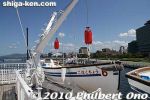
On the 3rd floor top deck, Uminoko has five cutter boats for 12 rowers each. There is also a motor boat. The cutter boats are used for rowing excursions. The cutters are named after waterfowl.Aug 19, 2010
|
|
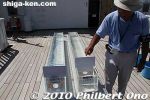
The water looked quite transparent to me. Couldn't quite understand the demo, and it was too hot under the sun to spend time asking questions.Aug 19, 2010
|
|
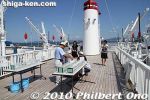
Top wooden deck on the 3rd floor. There was a water transparency demonstration amid cutter boats. 3階甲板Aug 19, 2010
|
|
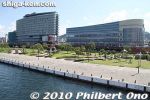
View from Uminoko moored at Otsu Port. On the right is Aqus shopping mall and left is Biwako Hotel.Aug 19, 2010
|
|
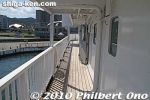
3rd floor. It is an interesting boat. The inside is clean and pleasant. Hard to believe that it's considered old at age 27. They should hold these open house events more often and at other ports like Nagahama.Aug 19, 2010
|
|
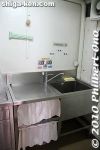
Aug 19, 2010
|
|
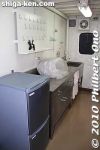
Aug 19, 2010
|
|
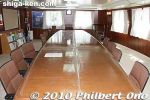
Conference RoomAug 19, 2010
|
|
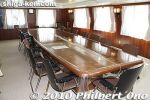
Conference Room is toward the bow on the 3rd floor. 会議室Aug 19, 2010
|
|
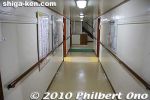
Corridor runs through the center of the boat, with sleeping quarters on both sides.Aug 19, 2010
|
|
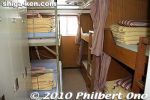
Teacher's (or maybe crew) quarters for four. Aug 19, 2010
|
|
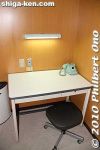
Spartan desk in teacher's quarters.Aug 19, 2010
|
|
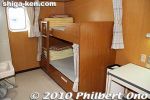
Teacher's quarters for two. Teachers' quarters are named after islands in Lake Biwa such as Chikubu, Okishima, and Shiraishi.Aug 19, 2010
|
|
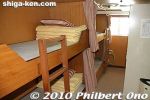
More teacher's quarters on the 3rd floor. This is for two. Aug 19, 2010
|
|
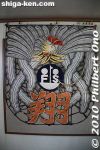
Yokaichi kite decorates the 4th floor。Aug 19, 2010
|
|
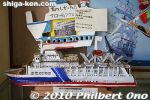
A former student's art work is displayed. Made of corrugated cardboard.Aug 19, 2010
|
|
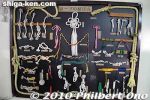
Tying rope is another thing the kids learn on the boat.Aug 19, 2010
|
|
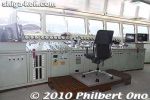
Pilot's chair. The Uminoko also has a bow thruster that is a propeller that can turn 360 degrees for easy steering. It doesn't need a tugboat.Aug 19, 2010
|
|
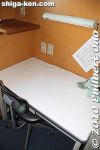
Teacher's deskAug 19, 2010
|
|
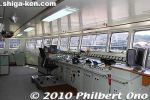
On the 4th floor is the bridge of the Uminoko. There is a small observation room behind the bridge where people can watch the captain and crew steer the boat. 操舵室Aug 19, 2010
|
|
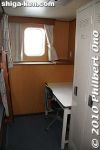
Room with a view in the teacher's quarters next to the shower room.Aug 19, 2010
|
|
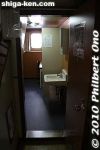
Entrance to teacher's quarters (named Kiho 帰帆) on the 1st floor.Aug 19, 2010
|
|
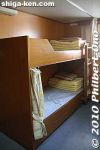
Bunk beds in teacher's quarters. One of my cousins is a school teacher in Shiga who went on Uminoko twice as a chaperone. She complained that you can't even sit up on the bunk bed. Well, I've seen worse on US Navy ships.Aug 19, 2010
|
|
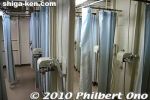
Boys' shower room with blue curtains.Aug 19, 2010
|
|
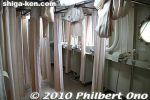
Girls' shower room has pink curtains.Aug 19, 2010
|
|
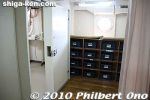
On the 1st floor toward the stern is the shower room. This is the changing area.Aug 19, 2010
|
|
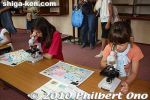
Looking at plankton through a microscope.Aug 19, 2010
|
|
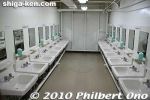
On the 1st floor toward the stern are these sinks next to the shower room.Aug 19, 2010
|
|
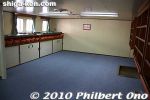
Sleeping quarters for boys have a blue carpet. There are six rooms like this one for boys, each one is named after a lake fish like Moroko, Ayu, and Funa.Aug 19, 2010
|
|
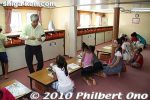
One activity they held during the tour was plankton observations through a microscope, held in sleeping quarters for girls.Aug 19, 2010
|
|

Sleeping quarters for boys. On the right is their cubby hole. These sleeping quarters can also be used as multi-purpose rooms.Aug 19, 2010
|
|
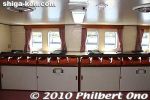
Sleeping quarters has orange life vests and blankets stored in the bins below. It's nice that all the sleeping quarters have real names instead of numbers like in a hotel.Aug 19, 2010
|
|
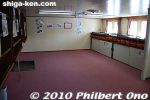
Sleeping quarters for girls have a pink carpet. There are six rooms for girls like this one, each one is named after a flower like Ume, Shakunage, and Botan. 宿泊室Aug 19, 2010
|
|
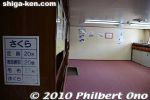
Sleeping quarters are on the 1st floor. This room is for 20 girls. They sleep on the floor. There are 12 rooms similar to this one. A total of 240 kids can thus be accommodated.Aug 19, 2010
|
|
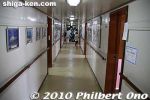
This corridor has photos of native Lake Biwa fish on the wall.Aug 19, 2010
|
|
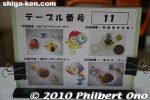
Cafeteria menu for the overnight voyage. The Uminoko curry is said to be famous. Too bad no sample meals were served during the open house.Aug 19, 2010
|
|
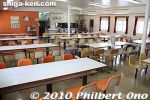
The cafeteria is on the 2nd floor toward the stern. It can hold 112 kids at one time. The chairs are small and immovable, designed for 5th graders. But adults won't have problems sitting.Aug 19, 2010
|
|
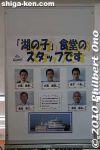
Galley staff. Uminoko's crew and galley staff are actually employees of Biwako Kisen Steamship Co. that also operates other cruise boats on Lake Biwa. They are contracted by Shiga Prefecture to work on Uminoko.Aug 19, 2010
|
|
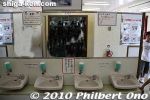
Wash basin in the cafeteria.Aug 19, 2010
|
|
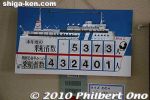
The number of people who went on an Uminoko voyage this year is on top, and the total number who went on a voyage on Uminoko since 1983 on the bottom. The 432,401 people is equivalent to one-third of Shiga's population.Aug 19, 2010
|
|
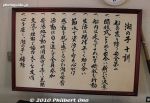
Rules on Uminoko: Safety first, Save water, No running, etc. During the current school year from April 2010 to Feb. 2011, Uminoko will go on over 90 overnight voyages.Aug 19, 2010
|
|

Lyrics of Kibo no Fune--Uminoko Shukoka (Ship of Hope--Lake Child Cruise Song). They created a song just for the boat in 1984. 希望の船--湖の子周航歌This is the 1st verse:
朝もやはれて さわやかに
さざ波光る びわのうみ
ぼくらわたしら 滋賀の子が
湖上たのしく めぐりつつ
郷土の知識 たかめあう
希望の船よ 希望の船よ
湖の子よAug 19, 2010
|
|
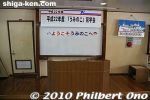
Podium in the Study Room.Aug 19, 2010
|
|
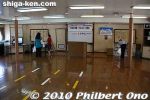
On the 2nd floor toward the bow is the large Study Room where they hold lectures, tug of war, etc. Usually, 5th graders from two or more schools go on the overnight voyages. Besides learning about the lake environment, the kids get to meet other kids. 学Aug 19, 2010
|
|
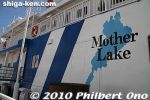
Mother Lake logo on Uminoko. From April 2001, the boat started using BDF (biodiesel fuel). It also has a small elevator (wheelchair accessible). Since the boat is over 25 years old, donations are being accepted for its replacement in several years.Aug 19, 2010
|
|

The boat has four floors. The upper three floors are made of aluminum alloy to make the ship lighter. We first entered the 2nd floor where there was a small lobby for us to change into indoor shoes.Aug 19, 2010
|
|
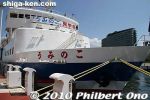
Uminoko is 65 meters long, 12 meters wide, and 20 meters high. It weighs 928 tons and can carry 240 people. It can cruise up to 8 or 9 knots. Hitachi Zosen built the boat in pieces in Kanagawa Prefecture which were then trucked to Lake Biwa and assembled.Aug 19, 2010
|
|
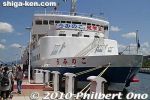
Previously, they held day-trip voyages for the public once or twice a year. We had to send in a postcard to apply. Usually over 500 people applied and only about 115 could get in. Now, due to a tight budget, they only hold these open house tours at port.Aug 19, 2010
|
|
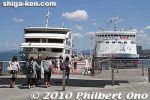
The Uminoko boat was moored next to the Bianca (left), Lake Biwa's largest cruise boat. While Crown Prince, Emperor Akihito and Empress Michiko once visited Uminoko in Aug. 1984. Prince Akinoshino and Princess Kiko visited in Nov. 2001.Aug 19, 2010
|
|
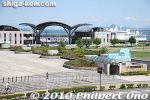
Otsu Port as seen from Hama-Otsu Station on the Keihan Line. Just a 3-min. walk from the station. The Uminoko can be seen on the right. Same port where the Michigan paddlewheel boat is based.Aug 19, 2010
|
|
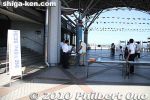
Reception counter at Otsu Port for the Uminoko tour (called kengakukai). We just had to sign our name and give a head count. We received a pamphlet and questionnaire.Aug 19, 2010
|
|
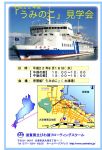
About once a year, the old Uminoko was open to the public for free while moored at Otsu Port. You could freely go inside and look at most of the rooms. I went on Aug. 18, 2010. This is the flyer for the tour called Kengakukai.Aug 19, 2010
|
|
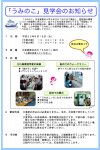
The open house consisted of two 2-hour sessions, one at 10 am to noon and another from 1 pm to 3 pm. Indoor shoes were required. A total of 616 visitors came in the morning and 468 in the afternoon.Aug 19, 2010
|
|
|
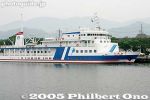
Operated by Shiga Prefecture's Board of Education, the Uminoko "Biwako Floating School" is an educational boat going on overnight voyages year-round on Lake Biwa, taking Shiga's 5th graders.This first and original Uminoko ship was in operation from Aug. 2, 1983 to spring 2018 when it was retired. It was replaced by a new Uminoko ship (same name) in May 2018. The following photos are of the old Uminoko ship inside and outside when it was open to the public in Aug. 2010.Aug 19, 2010
|
|

Jul 13, 2009
|
|

Dock for Setagawa River boat cruise in Otsu.Jul 13, 2009
|
|

The Seta are is also accessible by bus.Jul 13, 2009
|
|
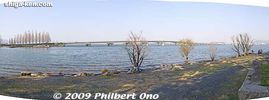
Lakeside at Zeze Castle Park with Omi Ohashi Bridge in the distance.Jul 12, 2009
|
|

Gift coupons in exchange for black bass and blue gill fish. If you catch a non-native fish like black bass and blue gill fish in the lake, don't throw it back into the lake. This was at Zeze Castle park.Jul 12, 2009
|
|

Local community center designed after Zeze Castle.Jul 12, 2009
|
|
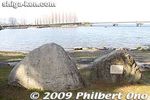
Jul 12, 2009
|
|
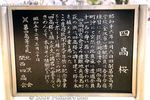
About the No. 4 High School (Yonko) cherry blossoms planted in 1977. 四高桜Jul 12, 2009
|
|

Zeze Castle was built in 1601 upon the order of Tokugawa Ieyasu after he won the Battle of Sekigahara in 1600. He dismantled Otsu Castle and assigned Zeze Castle as a guard for the Tokaido Road.Jul 12, 2009
|
|
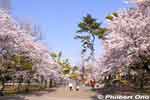
Zeze Castle's main path to the lake shore is lined with cherry trees.Jul 12, 2009
|
|

Jul 12, 2009
|
|
| 2449 files on 10 page(s) |
 |
3 |  |
 |
 |
|